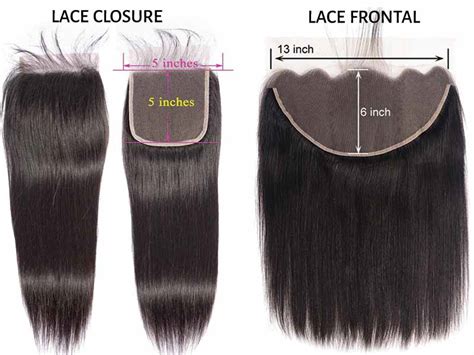When seeking a solution to hair loss, both closure and frontal hair replacement methods offer viable options with varying advantages and disadvantages. Understanding the key distinctions between these techniques is crucial for making an informed decision that best suits your individual needs.

Closure vs. Frontal: Understanding the Differences
1. Definition and Construction:
– Closure: A small, round hairpiece typically 4×4 inches in size, crafted to cover a specific area of hair loss on the scalp.
– Frontal: A larger hairpiece that extends around the perimeter of the head, covering the entire frontal hairline, and often extending to the crown.
2. Application Process:
– Closure: Secured to the scalp using glue or tape, creating a secure attachment.
– Frontal: Bonded or sewn onto the existing hair, offering a more permanent solution.
3. Coverage:
– Closure: Limited coverage, targeting specific areas of hair loss.
– Frontal: Provides complete coverage of the front hairline and top of the scalp.
4. Versatility:
– Closure: Allows for versatility in styling, as the rest of the natural hair remains visible.
– Frontal: Restricts styling options due to the complete coverage it provides.
Pros and Cons of Closure vs. Frontal
Closure:
- Pros:
- Affordable option compared to frontals.
- Less commitment as it covers only specific areas.
- Allows for natural hair integration.
- Cons:
- Visible seams or edges, especially with short hairstyles.
- Limited coverage, may not be suitable for extensive hair loss.
Frontal:
- Pros:
- Provides complete and seamless coverage.
- Offers a more natural-looking hairline.
- Suitable for individuals with extensive hair loss or thinning.
- Cons:
- More expensive investment than closures.
- More time-consuming and complex installation process.
- May cause scalp irritation or tension due to the extensive bonding.
Making the Right Choice: Factors to Consider
To determine the ideal hair replacement method between closure and frontal, consider the following factors:
- ** Extent of hair loss**
- Budget
- Desired coverage and style
- Expected longevity of the hairpiece
- Comfort and maintenance preferences
Additional Considerations:
1. Lace Base vs. Poly Base:
– Lace Base: Provides a more natural appearance but requires meticulous care to avoid tearing.
– Poly Base: More durable and affordable, but may appear less realistic.
2. Density and Texture:
– Density: Refers to the number of hairs per square inch. Higher density provides a fuller look.
– Texture: Choose a texture that matches your natural hair to ensure a seamless blend.
3. Customization Options:
– Custom Color Blending: Tailors the hairpiece to perfectly match your hair color for a natural look.
– Bleaching and Toning: Allows you to further customize the hairpiece to achieve your desired highlights or lowlights.
Innovative Applications in Closure and Frontal Hair Replacement
1. Scalp Micropigmentation: A non-surgical procedure that creates the illusion of hair follicles on the scalp, enhancing the realistic appearance of a closure or frontal.
2. BlendID: A revolutionary application that uses advanced technology to create custom hairpieces that blend seamlessly with your natural hair, ensuring an undetectable transition.
Frequently Asked Questions (FAQs)
1. How long does it take to install a closure or frontal?
– Closure: 1-2 hours on average.
– Frontal: 2-4 hours on average.
2. How often do I need to maintain my closure or frontal?
– Weekly wash and conditioning.
– Bi-weekly to monthly reattachment or adjustments.
3. How do I care for my closure or frontal?
– Use sulfate-free shampoos and conditioners.
– Gently brush or comb to avoid tangling.
– Avoid harsh chemicals or heat styling.
Conclusion
Whether you opt for a closure or frontal hair replacement method, the key is to make an informed decision that aligns with your individual needs and preferences. By carefully considering the differences, pros and cons, and additional factors discussed in this guide, you can achieve the desired results and restore your hair with confidence.
